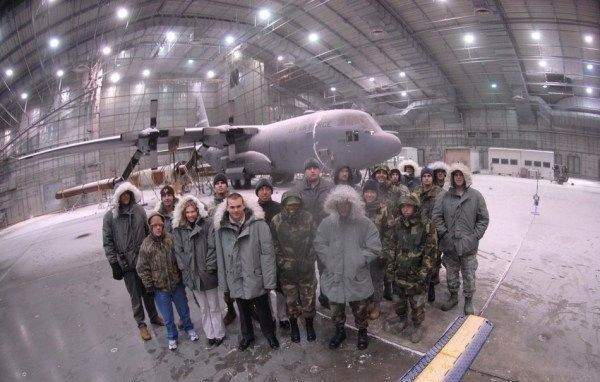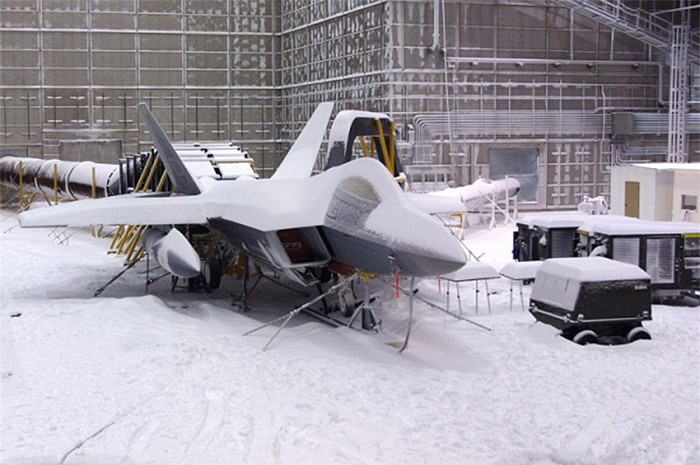The room where the US Army created snow ice storms to test weapons
Why are US military weapons and weapons well tolerated by harsh environments to be present in many countries around the world?
If you see glamorous snowmen in the warm weather of the coastal city of Destin, Florida, aren't they silly. These people are about to enter the giant room that can create all kinds of US Army weather, simulating all environments from the extreme heat of the desert to the snow and ice of Alaska.

Inside the US snow room.
McKinley climate lab was built in 1947, at Eglin Air Force Base, Florida. Inside it were giant insulated rooms. Largest room with an area of 5,100m2, 21m high. Along with two other smaller rooms, they were used by the US military to test more than 300 models of their military aircraft for nearly 70 years.
Recalling history, the US military's global war in World War II posed a small challenge: aircraft had to withstand a variety of cold weather like Alaska, hot desert. Middle East to Southeast Asia tropical rainforest.
In addition, the failure of the Nazi airplanes to take off in the cold weather of 1942-1943 winter gave the United States a great lesson without paying the price. They immediately realized the need to test their aircraft in all weather conditions.

An F-22 covered with snow inside the McKinley Climate Laboratory.
Previously, in 1940, a cold weather laboratory was built in Alaska to take advantage of the icy climate. However, the weather here is constantly changing and cannot be accurately predicted, making the effectiveness of the tests limited.
In 1943, the United States Air Force was tasked with finding new solutions. Meanwhile, Ashley C. McKinley, a lieutenant colonel officer, proposed building a weather control laboratory at Eglin Air Force Base, Florida. The plan was approved in 1944. However, due to the difficult conditions of the war period, in 1947 this experimental facility was completed and put into use. It is named after Lieutenant Colonel McKinley.
The Airbus A350 undergoes testing at McKinley.
In the first 50 years, as McKinley predicted, this lab offers trials that cost less than 10 times the old Alaska facility that still performs much better.
More than 300 different types of aircraft from (B-29 to F-22) have been tested by the US Army. Besides, 2,000 other weapons and vehicles have also experienced severe weather at the McKinley climate laboratory.
Civil aircraft operators also hired McKinley to test their products, typically two models of the Boeing 787 and the Airbus 350. Ford also sent cars to test its stamina. .
Ford cars are also included in the cold weather.
In terms of design, the McKinley Climate Laboratory has a main chamber 21m high, 77m long and 61m wide. It can accommodate large aircraft such as B-29. In 1968, the main chamber was expanded to 5,100 square meters. Under favorable conditions, it can reach the test temperature of 74 o C.
Smaller multi-weather room with dimensions of 13x7m. It can create a temperature range of -62 o C to 77 o C, conditions up to 380mm per hour of rainfall and 31m / s wind speed. Snow and ice can perfectly simulate in this room.

Inside the lab's main chamber.
Besides, there is an altitude testing room with size of 4x3m, 2m high. It can simulate weather at a height of 24km, range from -62 ° C to 60 ° C. Many other large rooms are also built to test tanks, motorized vehicles, ammunition and equipment. .
Materials used to build up insulation walls are galvanized steel sheets. They are stuffed with fiberglass inside with a thickness of 33cm. The doors are heat-resistant with foam rubber foam. The roof is also designed with thermal insulation.

Ice and snow conditions can be accurately simulated.
McKinley Laboratory uses 3 cooling systems with R-12 gas, a non-toxic refrigerant. They give cooling capacity from 27 o C to -54 o C in just 40 minutes. Besides, deep-water steam generators are used to simulate stormy weather, high humidity and snow ice. In contrast, heaters and heating systems, light bulbs are used to describe the types of hot weather and UV rays of the sun.
In developing weapons in general and military aircraft in particular, the United States has deployed a series of massive labs alongside McKinley in the past. Typical of these may include the secretive Area 51, 100km north of Las Vegas. Therefore, the weapons and weapons of the US military often have good stamina with the harshness of the environment. It is a reason for them to be present and used by many countries around the world.
- The US Army expects to shoot down aircraft with counter-air laser weapons
- He is ready to mobilize the army to deal with the snowstorm
- USA: Anchorage city snowed 3.4m
- Turkey successfully tried electromagnetic weapons faster than the US
- The deadly weapon of the terracotta army, the tomb of Qin Shi Huang
- Scientists are concerned about the US plan to create
- Top 5 most powerful weapons of the French army
- Winter storm attacks the US, 13 people die
- The US is about to test stealth laser weapons
- Snowstorm in Japan injured more than 1,600 people
- Snow and storms occur in some European countries
- Putin's military weapon unexpectedly caused terrorists to cry
 Norway built the world's tallest wooden tower
Norway built the world's tallest wooden tower Kremlin
Kremlin Ashurbanipal: The oldest royal library in the world
Ashurbanipal: The oldest royal library in the world Decoding the thousand-year construction of Qin Shihuang shocked the world
Decoding the thousand-year construction of Qin Shihuang shocked the world Robot camera network operating at 26,000m
Robot camera network operating at 26,000m  Before the invention of weather forecasting, how did ancient people predict storms?
Before the invention of weather forecasting, how did ancient people predict storms?  Chile recorded its coldest May in more than 70 years
Chile recorded its coldest May in more than 70 years  Why is the weather in the North still as cool as late Spring at the end of May?
Why is the weather in the North still as cool as late Spring at the end of May?  The 300-year-old relic suddenly 'appeared' in the middle of the dam
The 300-year-old relic suddenly 'appeared' in the middle of the dam  What happened in 1816, when Earth saw a year 'without a summer'?
What happened in 1816, when Earth saw a year 'without a summer'? 